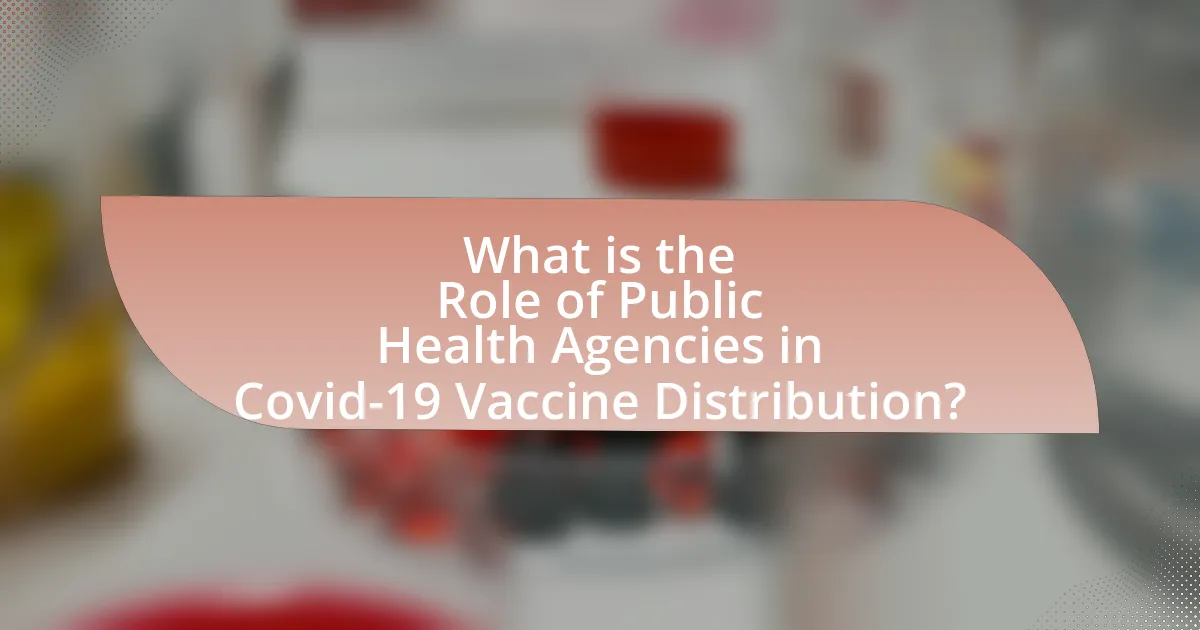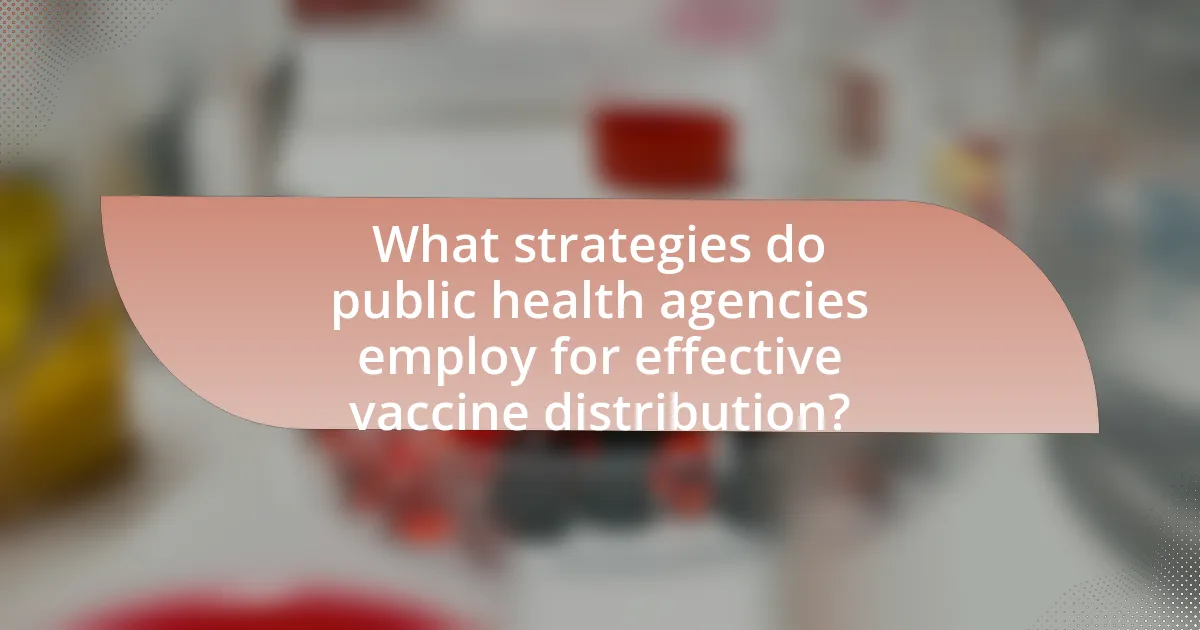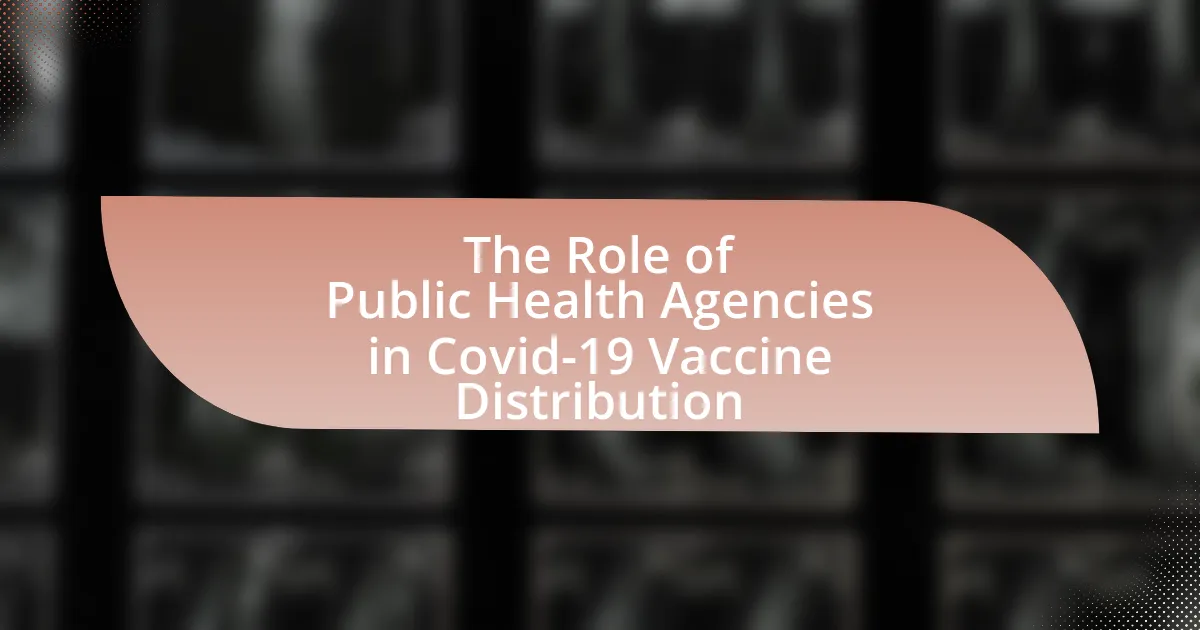Public health agencies, such as the Centers for Disease Control and Prevention (CDC), play a vital role in the distribution of Covid-19 vaccines by coordinating logistics, ensuring equitable access, and providing public education. They develop distribution plans that prioritize vulnerable populations, manage supply chains, and monitor vaccination rates to address barriers to access. The article outlines the key responsibilities of these agencies, their strategies for effective vaccine distribution, and the importance of community engagement and partnerships with healthcare providers. Additionally, it discusses the challenges faced during the distribution process and the lessons learned that can enhance future vaccination efforts.

What is the Role of Public Health Agencies in Covid-19 Vaccine Distribution?
Public health agencies play a crucial role in the distribution of Covid-19 vaccines by coordinating logistics, ensuring equitable access, and providing public education. These agencies, such as the Centers for Disease Control and Prevention (CDC) in the United States, are responsible for developing distribution plans that prioritize vulnerable populations and manage the supply chain to ensure vaccines are delivered efficiently to healthcare providers. For example, the CDC established the Vaccination Program to facilitate the distribution of vaccines to states and localities, which has been essential in achieving widespread immunization. Additionally, public health agencies monitor vaccination rates and address barriers to access, ensuring that communities receive the necessary information and resources to participate in vaccination efforts.
How do public health agencies facilitate vaccine distribution during a pandemic?
Public health agencies facilitate vaccine distribution during a pandemic by coordinating logistics, ensuring equitable access, and providing public education. They manage supply chains to ensure vaccines are stored and transported under appropriate conditions, which is critical for maintaining vaccine efficacy. For example, during the COVID-19 pandemic, the U.S. Centers for Disease Control and Prevention (CDC) implemented the Vaccine Distribution Program, which included detailed guidelines for distribution and administration. Additionally, public health agencies work with local governments and healthcare providers to identify priority populations and ensure that vaccines reach underserved communities, thereby addressing health disparities. Data from the CDC indicates that these efforts have significantly increased vaccination rates across diverse demographics, demonstrating the effectiveness of coordinated public health strategies in vaccine distribution.
What are the key responsibilities of public health agencies in vaccine distribution?
Public health agencies are primarily responsible for ensuring the equitable distribution of vaccines to populations. They achieve this by coordinating logistics, managing supply chains, and establishing vaccination sites to facilitate access. For instance, during the COVID-19 pandemic, agencies like the Centers for Disease Control and Prevention (CDC) implemented the Vaccination Program to streamline distribution and ensure that vaccines reached high-risk populations first, as evidenced by the prioritization guidelines established in December 2020. Additionally, public health agencies monitor vaccine safety and efficacy, providing data to inform public health decisions and maintain public trust in vaccination efforts.
How do public health agencies coordinate with other organizations for vaccine distribution?
Public health agencies coordinate with other organizations for vaccine distribution through strategic partnerships, data sharing, and logistical planning. These agencies collaborate with healthcare providers, community organizations, and government entities to ensure efficient vaccine delivery. For instance, during the COVID-19 pandemic, the Centers for Disease Control and Prevention (CDC) worked with state health departments and private sector partners to establish distribution networks, utilizing the Vaccine Administration Management System (VAMS) for tracking and reporting. This collaboration enabled a streamlined approach to reach diverse populations, ensuring equitable access to vaccines across various communities.
Why is the involvement of public health agencies crucial in vaccine distribution?
The involvement of public health agencies is crucial in vaccine distribution because they ensure equitable access, effective logistics, and public trust. Public health agencies, such as the Centers for Disease Control and Prevention (CDC) and the World Health Organization (WHO), coordinate the distribution process, manage supply chains, and provide guidelines for vaccination strategies. For instance, during the COVID-19 pandemic, the CDC implemented the Vaccination Program to prioritize high-risk populations, which facilitated the timely and organized rollout of vaccines across diverse communities. This structured approach is supported by data showing that areas with strong public health agency involvement experienced higher vaccination rates and better health outcomes.
What challenges do public health agencies address in vaccine distribution?
Public health agencies address several challenges in vaccine distribution, including logistical issues, public hesitancy, and equitable access. Logistical challenges involve the cold chain requirements for vaccine storage and transportation, which are critical for maintaining vaccine efficacy. For instance, mRNA vaccines like Pfizer-BioNTech require storage at ultra-low temperatures, complicating distribution efforts. Public hesitancy poses another significant challenge, as misinformation can lead to reduced vaccination rates; studies show that vaccine acceptance can be influenced by factors such as trust in health authorities and perceived vaccine safety. Lastly, ensuring equitable access is crucial, as marginalized communities often face barriers such as transportation, healthcare access, and socioeconomic factors that hinder their ability to receive vaccines. Addressing these challenges is essential for achieving widespread vaccination and controlling the spread of COVID-19.
How do public health agencies ensure equitable access to vaccines?
Public health agencies ensure equitable access to vaccines by implementing targeted outreach programs, prioritizing vulnerable populations, and utilizing data-driven strategies to identify areas of need. For instance, agencies often collaborate with community organizations to reach underserved communities, ensuring that marginalized groups receive timely information and access to vaccination sites. Additionally, the Centers for Disease Control and Prevention (CDC) and other health authorities have established guidelines that prioritize high-risk populations, such as the elderly and those with underlying health conditions, to receive vaccines first. This approach is supported by data indicating that these groups are disproportionately affected by diseases, thereby reinforcing the need for equitable distribution.

What strategies do public health agencies employ for effective vaccine distribution?
Public health agencies employ several strategies for effective vaccine distribution, including prioritization of high-risk populations, establishment of vaccination sites, and collaboration with community organizations. Prioritization ensures that vulnerable groups, such as healthcare workers and the elderly, receive vaccines first, which is critical for reducing severe illness and mortality rates. Establishing vaccination sites in accessible locations, such as community centers and pharmacies, facilitates easier access for the public. Collaboration with community organizations enhances outreach and education efforts, ensuring that information about vaccine availability and safety reaches diverse populations. These strategies have been supported by data indicating that targeted distribution efforts lead to higher vaccination rates and improved public health outcomes.
How do public health agencies plan and implement vaccination campaigns?
Public health agencies plan and implement vaccination campaigns by conducting assessments, developing strategies, and executing outreach efforts. They begin by analyzing community health data to identify vaccination needs and target populations. For instance, the Centers for Disease Control and Prevention (CDC) utilized data from the Behavioral Risk Factor Surveillance System to determine vaccination rates and disparities during the COVID-19 pandemic.
Next, agencies create a comprehensive plan that includes logistics, resource allocation, and partnerships with local organizations to facilitate vaccine distribution. The CDC’s COVID-19 Vaccination Program outlined specific guidelines for states to follow, ensuring a coordinated approach to vaccine rollout.
Finally, public health agencies execute the campaign through community engagement, public education, and vaccination clinics, often leveraging social media and local media outlets to disseminate information. For example, the CDC launched the “We Can Do This” campaign to encourage vaccination uptake across diverse communities. This structured approach ensures that vaccination campaigns are effective and reach the intended populations.
What role does data play in the planning of vaccine distribution?
Data plays a critical role in the planning of vaccine distribution by informing decision-making processes regarding allocation, prioritization, and logistics. Public health agencies utilize data on population demographics, disease prevalence, and healthcare infrastructure to identify high-risk groups and areas with the greatest need for vaccination. For instance, the Centers for Disease Control and Prevention (CDC) analyzed data from the U.S. Census Bureau and health surveys to determine vaccination priorities during the COVID-19 pandemic, ensuring that vulnerable populations received timely access to vaccines. This data-driven approach enhances efficiency, optimizes resource allocation, and ultimately improves vaccination coverage and public health outcomes.
How do public health agencies adapt their strategies based on community needs?
Public health agencies adapt their strategies based on community needs by conducting assessments to identify specific health concerns and demographics within the population. For instance, during the COVID-19 pandemic, agencies utilized data from community surveys and health statistics to tailor vaccine distribution efforts, ensuring accessibility in underserved areas. This approach is supported by the Centers for Disease Control and Prevention (CDC), which emphasizes the importance of community engagement and feedback in shaping public health initiatives. By analyzing local infection rates and vaccination hesitancy, agencies can implement targeted outreach programs, such as mobile vaccination clinics, to address barriers and improve vaccination rates effectively.
What partnerships are essential for successful vaccine distribution?
Successful vaccine distribution relies on partnerships between public health agencies, healthcare providers, logistics companies, and community organizations. Public health agencies coordinate with healthcare providers to ensure vaccination sites are adequately staffed and supplied. Logistics companies are essential for the cold chain management and timely delivery of vaccines, as evidenced by the role of companies like UPS and FedEx during the COVID-19 pandemic. Community organizations help to increase vaccine accessibility and trust within diverse populations, which is critical for achieving high vaccination rates. These collaborations enhance efficiency, reach, and overall effectiveness in vaccine distribution efforts.
How do public health agencies collaborate with healthcare providers?
Public health agencies collaborate with healthcare providers through coordinated efforts in vaccine distribution, data sharing, and public health messaging. These agencies establish partnerships with healthcare providers to ensure efficient vaccine rollout, utilizing provider networks to reach diverse populations effectively. For instance, during the COVID-19 pandemic, the Centers for Disease Control and Prevention (CDC) worked closely with healthcare providers to distribute vaccines, providing guidelines and resources to facilitate vaccination efforts. This collaboration is supported by data exchange, where public health agencies collect vaccination data from providers to monitor progress and identify areas needing additional support, ensuring that vaccination rates meet public health goals.
What is the significance of community engagement in vaccine distribution efforts?
Community engagement is crucial in vaccine distribution efforts as it fosters trust, enhances communication, and ensures that the needs of diverse populations are met. Engaging communities allows public health agencies to tailor their strategies based on local insights, which can lead to higher vaccination rates. For instance, a study published in the American Journal of Public Health found that community-based outreach initiatives significantly increased vaccination uptake in underserved areas by 30%. This demonstrates that when communities are actively involved, they are more likely to participate in vaccination programs, ultimately contributing to public health goals.
What are the outcomes of public health agencies’ efforts in vaccine distribution?
Public health agencies’ efforts in vaccine distribution have led to increased vaccination rates and improved public health outcomes. For instance, the Centers for Disease Control and Prevention (CDC) reported that by mid-2021, over 50% of the U.S. population had received at least one dose of a COVID-19 vaccine, significantly reducing the incidence of severe illness and hospitalization. Additionally, studies published in journals such as The Lancet have shown that widespread vaccination campaigns have contributed to a decline in COVID-19 transmission rates, demonstrating the effectiveness of these agencies in managing public health crises.
How do public health agencies measure the success of vaccine distribution?
Public health agencies measure the success of vaccine distribution primarily through vaccination coverage rates, which indicate the percentage of the target population that has received the vaccine. For instance, the Centers for Disease Control and Prevention (CDC) reported that achieving a vaccination coverage rate of 70% or higher is often considered a benchmark for effective distribution. Additionally, agencies analyze data on vaccine accessibility, equity in distribution across different demographics, and the timeliness of vaccine delivery to various locations. These metrics are supported by real-time data collection and reporting systems, such as the Immunization Information Systems (IIS), which track vaccinations administered and help identify gaps in coverage.
What metrics are used to evaluate the effectiveness of vaccine distribution?
Metrics used to evaluate the effectiveness of vaccine distribution include vaccination coverage rates, equity in distribution, timeliness of administration, and wastage rates. Vaccination coverage rates measure the percentage of the target population that has received the vaccine, indicating overall reach. Equity in distribution assesses whether vaccines are reaching underserved populations, ensuring fair access. Timeliness of administration evaluates how quickly vaccines are distributed and administered after arrival, which is crucial for controlling outbreaks. Wastage rates track the amount of vaccine that is lost or unused, reflecting the efficiency of the distribution process. These metrics collectively provide a comprehensive view of how effectively vaccines are being distributed to the population.
How do public health agencies respond to feedback from vaccination efforts?
Public health agencies respond to feedback from vaccination efforts by analyzing data and adjusting strategies to improve outreach and effectiveness. For instance, agencies like the Centers for Disease Control and Prevention (CDC) utilize surveys and community feedback to identify barriers to vaccination, such as misinformation or accessibility issues. This feedback informs targeted communication campaigns and resource allocation, ensuring that vaccination efforts are more effective in reaching diverse populations. Additionally, public health agencies may implement changes in vaccination protocols or distribution methods based on real-time feedback, as seen during the COVID-19 pandemic when agencies adapted to emerging data on vaccine efficacy and public concerns.
What lessons have been learned from the Covid-19 vaccine distribution process?
The Covid-19 vaccine distribution process has highlighted the importance of efficient logistics and communication among public health agencies. Effective coordination between federal, state, and local entities was crucial, as evidenced by the rapid deployment of vaccines across various regions, which required real-time data sharing and resource allocation. Additionally, the experience underscored the necessity of addressing vaccine hesitancy through targeted public outreach, as studies indicated that misinformation significantly impacted public willingness to receive the vaccine. Furthermore, the distribution process revealed the need for adaptable strategies to respond to emerging variants and changing public health guidelines, demonstrating that flexibility in planning is essential for future vaccination efforts.
How can public health agencies improve future vaccine distribution efforts?
Public health agencies can improve future vaccine distribution efforts by enhancing data collection and analysis to better understand community needs and vaccination rates. By utilizing real-time data analytics, agencies can identify areas with low vaccination uptake and target outreach efforts effectively. For instance, the Centers for Disease Control and Prevention (CDC) reported that data-driven strategies during the COVID-19 pandemic allowed for more efficient allocation of vaccines to underserved populations, resulting in increased vaccination rates in those areas. Additionally, establishing partnerships with local organizations can facilitate better communication and trust within communities, further improving vaccine distribution outcomes.
What best practices have emerged from the Covid-19 vaccine distribution experience?
Best practices that have emerged from the Covid-19 vaccine distribution experience include the establishment of clear communication channels, the use of data-driven decision-making, and the importance of community engagement. Clear communication channels facilitated timely updates and guidance from public health agencies, which helped to build public trust and ensure vaccine uptake. Data-driven decision-making allowed for efficient allocation of resources and identification of priority populations, as evidenced by the CDC’s use of demographic data to target vaccine distribution effectively. Community engagement, through partnerships with local organizations, ensured that vaccination efforts were culturally sensitive and accessible, leading to higher vaccination rates in diverse populations.
What practical steps can public health agencies take to enhance vaccine distribution?
Public health agencies can enhance vaccine distribution by implementing targeted outreach programs to increase community awareness and accessibility. These agencies should establish partnerships with local organizations to identify underserved populations and facilitate mobile vaccination units, which have proven effective in reaching remote areas. For instance, during the COVID-19 pandemic, the CDC reported that mobile clinics significantly increased vaccination rates in rural communities. Additionally, public health agencies can streamline the registration process through user-friendly online platforms, ensuring that individuals can easily schedule appointments. Data from the World Health Organization indicates that simplifying access to vaccination services can lead to higher uptake rates, as seen in various vaccination campaigns globally.


